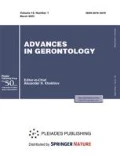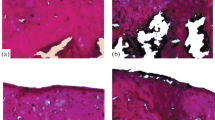Abstract
The purpose of the study is to find the age-related features of changes in the levels of heat shock proteins (HSPs), chemokines, and a marker of collagen degradation in the blood of patients with osteoarthritis. The survey revealed that the involvement of HSPs in the pathogenesis of osteoarthrosis seems to be a complex and multilevel process. Under the influence of external risk factors, HSP70 acts as an adjuvant to the immune reaction involving chemokine CXCL17. Low levels of HSPs do not allow them to act as an autoimmune factor in the interaction with Toll-like receptors of immunocompetent cells, but they obviously contribute to the CXCL17-dependent activation of dendritic cells and macrophages that initiate local inflammation involving key cytokines, including TNF-α. Chondrocytes and osteoblasts subjected to a cytokine attack are not able to respond fully to the overexpression of HSP70 and HSP27 for whatever reason. With aging, the pathophysiology of osteoarthritis enters the phase of the local tissue reaction, where the processes of hypertrophic differentiation of chondrocytes and osteo-like cells of subchondral bone play an important role.
Similar content being viewed by others
References
Andreeva, L.I., Theoretical and applied role of heat shock proteins 70 kDa: possible practical application and pharmacological correction, Obz. Klin. Farmakol. Ter., 2002, vol. 2, no. 2, pp. 2–18.
Anisimov, V.N., Aging and age-related diseases, Klin. Gerontol., 2005, no. 1, pp. 42–49.
Kabalyk, M.A., Dubikov, A.I., and Petrikeeva, T.Yu., The phenomenon of microcrystalline stress in osteoarthritis, Tikhookean. Med. Zh., 2014, no. 1, pp. 70–74.
Kabalyk, M.A., Gel’tser, B.I., Osipov, A.L., and Fadeev, M.F., Heat shock proteins are involved into the pathogenesis of osteoarthritis, Kazan. Med. Zh., 2016, vol. 97, no. 5, pp. 624–630.
Kuznik, B.I., Lin’kova, N.S., and Khavinson, V.Kh., Heat shock proteins: changes related to aging, development of thrombotic complications, and peptide regulation of the genome, Adv. Gerontol., 2012, vol. 2, no. 3, pp. 175–186.
Khavinson, V.Kh., Benberin, V.V., Mikhailova, O.N., and Sidorenko, A.V., Aging in developing countries: challenges and opportunities, Uprav. Konsult., 2015, vol. 11, no. 83, pp. 50–58.
Auger, I., Ragni, E., Reviron, D., et al., Immune response to 70 kD heat shock proteins and rheumatoid arthritis: implication of HLA-DRB1*0401, Clin. Exp. Rheumatol., 2007, vol. 25, no. 6, pp. 933–934.
Bianchi, A., Moulin, D., Hupont, S., et al., Oxidative stress-induced expression of HSP70 contributes to the inhibitory effect of 15d-PGJ2 on inducible prostaglandin pathway in chondrocytes, Free Radicals Biol. Med., 2014, vol. 76, pp. 114–126. doi 10.1016/j.freeradbiomed. 2014.07.028
Divorty, N., Mackenzie, A.E., Nicklin, S.A., and Milligan, G., G protein-coupled receptor 35: an emerging target in inflamatory and cardiovascular disease, Front. Pharmacol., 2015, vol. 10, no. 6, p. 41. doi 10.3389/fphar.2015.00041
Dwinell, M.B., Lugering, N., Eckmann, L., and Kagnoff, M.F., Regulated production of interferon-inducible T-cell chemoattractants by human intestinal epithelial cells, Gastroenterology, 2001, vol. 120, pp. 49–59.
Fan, Z., Bau, B., Yang, H., et al., Freshly isolated osteoarthritic chondrocytes are catabolically more active than normal chondrocytes, but leßs responsive to catabolic stimulation with interleukin-1ß, Arthritis Rheumatol., 2005, vol. 52, no. 1, pp. 136–143.
Grafe, I., Alexander, S., Yang, T., et al., Sclerostin antibody treatment improves the bone phenotype of crtap(–/–) mice, a model of recessive osteogenesis imperfecta, J. Bone Miner. Res., 2016, vol. 31, no. 5, pp. 1030–1040. doi 10.1002/jbmr.2776
Holmes, D.F., Graham, H.K., Trotter, J.A., et al., STEM/TEM studies of collagen fibril assembly, Micron, 2001, vol. 32, pp. 273–285.
Hsu, H.C., Chang, W.M., Wu, J.Y., et al., Folate deficiency triggered apoptosis of synoviocytes: role of overproduction of reactive oxygen species generated via NADPH oxidase/mitochondrial complex ii and calcium perturbation, PLoS One, 2016, vol. 11, no. 1, p. e0146440.
Kang, E.H., Kim, D.J., Lee, E.Y., et al., Downregulation of heat shock protein 70 protects rheumatoid arthritis fibroblast-like synoviocytes from nitric oxideinduced apoptosis, Arthritis Res. Ther., 2009, vol. 11, p. R130. doi 10.1186/ar2797
Lambrecht, S., Juchtmans, N., and Elewaut, D., Heatshock proteins in stromal joint tissues: innocent bystanders or diseaseinitiating proteins?, Rheumatology (Oxford, U.K.), 2014, vol. 53, no. 2, pp. 223–232. doi 10.1093/rheumatology/ket277
Lee, W.Y., Wang, C.J., Lin, T.Y., et al., CXCL17, an orphan chemokine, acts as a novel angiogenic and antiinflammatory factor, Am. J. Physiol. Endocrinol. Metab., 2013, vol. 304, no. 1, pp. 32–40. doi 10.1152/ajpendo.00083.2012
Luttrell, L.M. and Gesty-Palmer, D., Beyond desensitization: physiological relevance of arrestin-dependent signaling, Pharmacol. Rev., 2010, vol. 62, pp. 305–330. doi 10.1124/pr.109.002436
Njemini, R., Bautmans, I., Onyema, O.O., et al., Circulating heat shock protein 70 in health, aging and disease, BMC Immunol., 2011, vol. 28, pp. 12–24.
Pockly, A.G., Muthana, M., and Calderwood, S.K., The dual immunoregulatory rols of stress proteins, Trends Biochem. Sci., 2008, vol. 33, pp. 71–79.
Rea, I.M., McNerlan, S., and Pockley, A.G., Serum heat shock protein and anti-heat shock protein antibody levels in aging, Exp. Gerontol., 2001, vol. 36, no. 2, pp. 341–352.
Schett, G., Redlich, K., Xu, Q., et al., Enhanced expression of heat shock protein 70 (hsp70) and heat shock factor 1 (HSF1) activation in rheumatoid arthritis synovial tissue. Differential regulation of hsp70 expression and HSF1 activation in synovial fibroblasts by proinflammatory cytokines, shear stress, and antiinflammatory drugs, J. Clin. Invest., 1998, vol. 102, pp. 302–311.
Shields, A.M., Panayi, G.S., and Corrigall, V.M., A new-age for biologic therapies: long-term drug-free therapy with BiP?, Front. Immunol., 2012, vol. 3, p. 17. doi 10.3389/fimmu.2012.00017
Yang, R.C., Chang, C.C., Sheen, J.M., et al., Davallia bilabiata inhibits TNF-a-induced adhesion molecules and chemokines by suppressing IKK/NF-kappa B pathway in vascular endothelial cells, Am. J. Clin. Med., 2014, vol. 42, no. 6, pp. 1411–1429. doi 10.1142/S0192415X1450089X
Yoda, M., Sakai, T., Mitsuyama, H., et al., Geranylgeranylacetone suppresses hydrogen peroxide-induced apoptosis of osteoarthritic chondrocytes, J. Orthop. Sci., 2011, vol. 16, no. 6, pp. 791–798. doi 10.1007/s00776-011-0138-z
Author information
Authors and Affiliations
Corresponding author
Rights and permissions
About this article
Cite this article
Kabalyk, M.A. Age-Related Aspects of the Involvement of Heat Shock Proteins in the Pathogenesis of Osteoarthritis. Adv Gerontol 7, 276–280 (2017). https://doi.org/10.1134/S2079057017040063
Published:
Issue Date:
DOI: https://doi.org/10.1134/S2079057017040063




